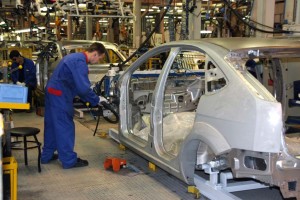
Ford isn't moving as many vehicles in Russia due to economic sanctions levied against the country for its involvement in the Ukrainian crisis.
Political and economic uncertainty in Eastern Europe and South America hit the bottom lines of General Motors and Ford during the second quarter, acknowledged executives the Detroit-area automakers.
The second quarter results from Russia and South America were disappointing but neither company showed any signs of walking away from either market.
Even Russia, which is embroiled in a conflict in the Ukraine that has led to the European Union and the United States impose economic sanctions that have slowed the Russian economy, neither company is prepared to walk away from their Russian partners or the substantial investments they have made in the Russian market.
“Russia is expected to be the largest market in Europe,” noted Mary Barra, General Motors’ chief executive officer.
“The current environment is difficult, but it’s a big, important market and it has the potential to be the largest market in Europe over time,” Ford Chief Executive Officer Mark Fields said. “You’ve got GDP that’s slowing down which is affecting industry sales, the weak ruble,” as well as the Ukraine crisis, he said.
Ford showed its first quarterly pretax profit in Europe in three years, despite a $329 million charge related to poor cash flow in the company’s joint venture with Russian carmaker, Sollers.
Fields said the weakness in Russia will not keep the company from its expectation of a full-year profit in Europe in 2015. Ford also remains committed to its investment in Russia and joint venture with Sollers, he said.
GM Chief Financial Officer Chuck Stevens also said during the company’s quarterly financial call that so far this year the automaker has cut production by 20% to 25% at its main plant in Russia in the face of falling demand.
GM also is exposed to currency fluctuations between the euro and the ruble. GM imports materials and parts from the euro zone to Russia, a potential stumbling block as tougher sanctions are discussed.
“Excluding the impact of restructuring, the losses in Europe were roughly $100 million, consistent with last year,” Stevens said, describing the results as “a pretty strong performance considering the incremental headwinds we have this year because of Russia.”
Car sales in the Ukraine, where the economy has ground to halt during the political upheaval that has gripped the nation since last fall, continue to fall after a more than 10% drop in 2013. Most car production in Ukraine now involves assembly of Korean, Chinese and Russian brands, which also export vehicles to the Ukraine before the current conflict.
South America also remains challenging, with slowing growth and inflation pressures in Brazil and severe economic policy imbalances in Argentina and Venezuela, Ford and GM executives.
GM’s Latin American operations swung from a $100 million in the second quarter of 2013 to a $200 million loss for the quarter ending June 30, according to the company’s financial statement.
(Ford posts $1.3 billion 2Q profit. For more, Click Here.)
Stevens noted part of the problem in the second quarter was that Brazil, which is by far the largest automotive market in South America, basically shutdown during the second quarter as the country hosted the World Cup tournament.
Brazil is also facing a stormy political season and neighboring Argentina is also facing political turmoil. Political turmoil also was behind the Venezuelan government’s decision to devalue the nation’s currency last winter.
(Click Here for details about GM’s 2Q earnings being crushed by recall costs.)
The devaluation led GM, Ford and Fiat Chrysler Automobiles operations, all of which operate plants in the South American country, facing steep financial penalties and cost constraints.
All three companies decided to shut down their Venezuelan operations because due to the financial turmoil created by the devaluation. GM expects to resume production at its plant in Venezuela during the third quarter, which bodes well for the future, Stevens said.
(To see more about the impact of the GM’s victims fund on the maker, Click Here.)
The larger problem, according to Fields, is that the economy in Brazil and the rest of South America has largely stopped growing and the industry-wide Seasonally Adjusted Annual Rate of sales or SAAR in South America has dropped from 6.1 million units to 5.3 million.
The economic slowdown was reflected in Ford’s financial performance during the second quarter as Ford revenue in South America declined by almost one third to $2.1 billion from $3 billion in the same period a year ago. Ford’s income dropped from a $151 million profit in the second quarter of 2013 to a loss of $205 million in the second quarter of 2014.

So at least half the BRICs are sick